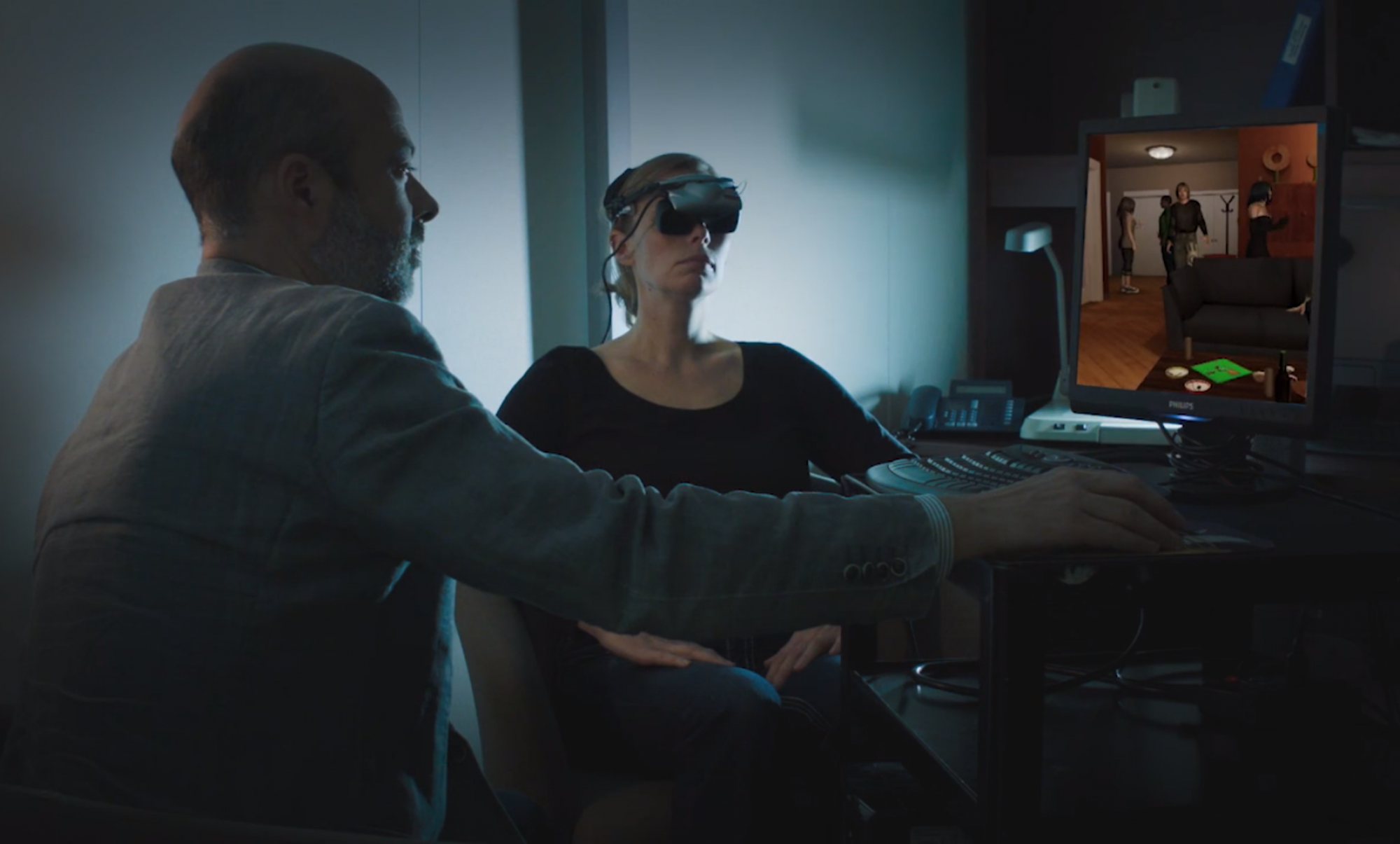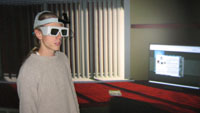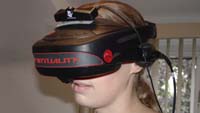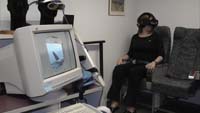Virtual reality and therapy in virtual environments are two relatively recent concepts in the field of mental health. On the other hand, the attributable processes underlying their development have been around for a very long time. For your interest, what follows are some interesting facts about virtual reality (Blade & Padgett, 2002):
1956 : Morton Heilig, film producer, developed « Sensorama », a mechanical virtual display device making it possible to view a film in 3D (three dimensions), while at the same time experiencing sensory stimulation from several sources (e.g. stereophony, vibrations, odours).
1961 : Philco built what is probably the first virtual reality helmet ever developed, making it possible to see « remotely » via a video camera (Kalawsky, 1993).
1963 : The technology employed in the creation of computer generated virtual environments was introduced, when Ivan Sutherland developed the first interactive computer graphics system called « Sketchpad », while at the Massachusetts Institute of Technology (MIT). This system created highly precise engineering drawings capable of being manipulated, duplicated and stored.
1968 : Ivan Sutherland joined David Evans to build a virtual helmet with at the University of UTAH. Daniel Vickers equipped a helmet with an apparatus allowing for the tracking of movements. Shortly thereafter, Thomas Furness developed a virtual reality helmet referred to as a « visually coupled system » while at the Wright-Patterson Air Force Base.
1969 : Whereas Sutherland and Furness focused on improving the technical aspects, Myron Krueger studied the artistic and psychological aspects of virtual environments at the University of Wisconsin. They initially invented «Glowflow», a an artistic sounds and light show controlled by a computer, but involving no computerized graphics. Thus, the audience could actively take part in the show of lights and sounds by moving around on pressure sensitive plates inserted into the floor without their knowledge. The following year, Krueger developed a much more elaborate system known as the « Metaplay ». The system was comprised of 800 pressure-sensitive switches and a projection screen measuring 8x 10 feet on which individuals viewed video images of themselves from a video camera, superimposed on computer graphics generated by a mini-computer.
1970 : In the 1970’s Krueger created even more elaborate artistic works that allowed interactive audience experiences, including the «Videoplace ». The « Videoplace » allowed individuals to immerge themselves into a computer-generated world inhabited by other human and virtual participants. In 1973, Krueger coined the term « artificial reality».
1973 : Krueger create the expression « artificial reality ».
1977 : Thomas Zimmerman invented one of the first commercial virtual gloves which was called the « DataGlove » (resulting form VPL research) operated by a programming language developed by Jaron Lanier. Also in 1977, Kit Galloway and Sherri Rabinowitz created a virtual space with the « Satellite Arts Project », realizing the vision of Arthur C. Clark and Marshall McLuhan, interconnecting the people of the world via electronic communication. Within a virtual space called « Hole in Space », they installed a large video screen and camera in public spaces in New York and Los Angeles to put into practice videoconferencing in a group setting. A decade later, they created the « Electronic Café » (http://www.ecafe.com/) in Santa Monica (California) introducing videoconferencing between individuals.
1979 : Researchers at MIT worked on the development of « spatial data management systems ». Moreover, Scott Fisher, one of the researchers at MIT, developed the stereophonic system using a virtual helmet.early
1980 : the Defence Advanced Research project Agency (DARPA) funded a global war game simulator called « Simulation Networking » or SIMNET. The evolution of this network made it possible for hundreds of soldiers to test their combat skills against one another in real time, much like a very realistic video game.
1981: Fisher and his colleagues produced the « Aspen Movie Map » wherein a user could visit 20 miles of streets in Aspen, Colorado. This product did not use a virtual helmet, but rather an elaborate « CAVE » (Cave Automatic Virtual Environment) system that projected scenes on the surrounding walls of a room.
1981 : Furness developed a virtual flight simulator for pilots. Since Sutherland and Furness’ early developments, virtual helmet technology has been in constant evolution, headed by various governmental organizations a private companies.
1984 : The movie entitled The Last Starfighter written by Jonathan R. Betuel merged live action scenes with computerized graphics making it possible to save millions of dollars in production costs. William Gibson also wrote a science fiction novel, « Neuromancer », in which he introduced the now-ubiquitous term « cyberspace ».
1985 : Jaron Lanier and Jean-Jacques Grimaud founded VPL Research, Inc., to produce state-of-the-art human interface devices. VPL Research became known for making what was intended to be the first consumer grade virtual environment hardware : the « DataGlove » and the « EyePhone ». Unfortunately, in a few years VPL research came on hard financial times and Lanier, the company and the products essentially disappeared. In addition, a research team headed by Dr. Frederick Brooks Jr. began experimenting with three dimensional (3D) perception of molecules at the University of North Carolina. In the decade that followed, the project developed into the « Nanomanipulator », where individuals wearing a virtual helmet could operate an electron microscope.
1986 : Lucasfilm, a company founded with revenues derived from the film series Star Wars (1976) began the production of computer generated films. In the years elapsed since, the film industry has used consistently more evolved computerized graphs, leading to a reduction in cost and to the creation of ever more astonishing visual effects.
1988 : Chris Gentile, of Abrams/Gentile Entertainment, developed the « PowerGlove » for Nintendo™, a best-selling toy. This glove was eventually discontinued at the end of 1991 because it failed to produce expected revenues.
1989 : The general public became aware of the concept of virtual environments and their potential, and enough people began working in the field that the first professional VE conferences were held. Also, Fakespace developed the BOOM™ (Binocular Omni Orientation Monitor), a virtual helmet mounted on a boom for tracking position. During the same year, a demonstration of virtual environments was carried using the system at SIGGRAPH. NASA developed a virtual helmet with liquid crystals, which made it possible to make the virtual helmets smaller and lighter.
1992 : The release of the movie « The Lawnmower Man » directed by Brett Leonard had virtual reality as its subject and made this technology very popular amongst the general public.
1993 : Silicon Graphics Inc. announced their « Reality Engine », a computer able to support significant virtual environment applications, beginning the era of rapidly expanding applications as computer power increased on relatively inexpensive pc’s.
1994 : Introduction of the first telesurgery systems.
1996 : With the creation of VRML (Virtual Reality Modeling Language) the development of virtual reality applications became easier. Finally, in a highly publicized application on virtual environments, astronauts were trained to do repairs on the Hubble space telescope using a full scale virtual environment simulator built at the Goddard Space Flight Centre.
1998 : The majority of virtual reality interfaces have become accessible to the general public.
1968 : Ivan Sutherland joined David Evans to build a virtual helmet with at the University of UTAH. Daniel Vickers equipped a helmet with an apparatus allowing for the tracking of movements. Shortly thereafter, Thomas Furness developed a virtual reality helmet referred to as a « visually coupled system » while at the Wright-Patterson Air Force Base.
1969 : Whereas Sutherland and Furness focused on improving the technical aspects, Myron Krueger studied the artistic and psychological aspects of virtual environments at the University of Wisconsin. They initially invented «Glowflow», a an artistic sounds and light show controlled by a computer, but involving no computerized graphics. Thus, the audience could actively take part in the show of lights and sounds by moving around on pressure sensitive plates inserted into the floor without their knowledge. The following year, Krueger developed a much more elaborate system known as the « Metaplay ». The system was comprised of 800 pressure-sensitive switches and a projection screen measuring 8x 10 feet on which individuals viewed video images of themselves from a video camera, superimposed on computer graphics generated by a mini-computer.
1970 : In the 1970’s Krueger created even more elaborate artistic works that allowed interactive audience experiences, including the «Videoplace ». The « Videoplace » allowed individuals to immerge themselves into a computer-generated world inhabited by other human and virtual participants. In 1973, Krueger coined the term « artificial reality».
1973 : Krueger create the expression « artificial reality ».
1977 : Thomas Zimmerman invented one of the first commercial virtual gloves which was called the « DataGlove » (resulting form VPL research) operated by a programming language developed by Jaron Lanier. Also in 1977, Kit Galloway and Sherri Rabinowitz created a virtual space with the « Satellite Arts Project », realizing the vision of Arthur C. Clark and Marshall McLuhan, interconnecting the people of the world via electronic communication. Within a virtual space called « Hole in Space », they installed a large video screen and camera in public spaces in New York and Los Angeles to put into practice videoconferencing in a group setting. A decade later, they created the « Electronic Café » (http://www.ecafe.com/) in Santa Monica (California) introducing videoconferencing between individuals.
1979 : Researchers at MIT worked on the development of « spatial data management systems ». Moreover, Scott Fisher, one of the researchers at MIT, developed the stereophonic system using a virtual helmet.early
1980 : the Defence Advanced Research project Agency (DARPA) funded a global war game simulator called « Simulation Networking » or SIMNET. The evolution of this network made it possible for hundreds of soldiers to test their combat skills against one another in real time, much like a very realistic video game.
1981: Fisher and his colleagues produced the « Aspen Movie Map » wherein a user could visit 20 miles of streets in Aspen, Colorado. This product did not use a virtual helmet, but rather an elaborate « CAVE » (Cave Automatic Virtual Environment) system that projected scenes on the surrounding walls of a room.
1981 : Furness developed a virtual flight simulator for pilots. Since Sutherland and Furness’ early developments, virtual helmet technology has been in constant evolution, headed by various governmental organizations a private companies.
1984 : The movie entitled The Last Starfighter written by Jonathan R. Betuel merged live action scenes with computerized graphics making it possible to save millions of dollars in production costs. William Gibson also wrote a science fiction novel, « Neuromancer », in which he introduced the now-ubiquitous term « cyberspace ».
1985 : Jaron Lanier and Jean-Jacques Grimaud founded VPL Research, Inc., to produce state-of-the-art human interface devices. VPL Research became known for making what was intended to be the first consumer grade virtual environment hardware : the « DataGlove » and the « EyePhone ». Unfortunately, in a few years VPL research came on hard financial times and Lanier, the company and the products essentially disappeared. In addition, a research team headed by Dr. Frederick Brooks Jr. began experimenting with three dimensional (3D) perception of molecules at the University of North Carolina. In the decade that followed, the project developed into the « Nanomanipulator », where individuals wearing a virtual helmet could operate an electron microscope.
1986 : Lucasfilm, a company founded with revenues derived from the film series Star Wars (1976) began the production of computer generated films. In the years elapsed since, the film industry has used consistently more evolved computerized graphs, leading to a reduction in cost and to the creation of ever more astonishing visual effects.
1988 : Chris Gentile, of Abrams/Gentile Entertainment, developed the « PowerGlove » for Nintendo™, a best-selling toy. This glove was eventually discontinued at the end of 1991 because it failed to produce expected revenues.
1989 : The general public became aware of the concept of virtual environments and their potential, and enough people began working in the field that the first professional VE conferences were held. Also, Fakespace developed the BOOM™ (Binocular Omni Orientation Monitor), a virtual helmet mounted on a boom for tracking position. During the same year, a demonstration of virtual environments was carried using the system at SIGGRAPH. NASA developed a virtual helmet with liquid crystals, which made it possible to make the virtual helmets smaller and lighter.
1992 : The release of the movie « The Lawnmower Man » directed by Brett Leonard had virtual reality as its subject and made this technology very popular amongst the general public.
1993 : Silicon Graphics Inc. announced their « Reality Engine », a computer able to support significant virtual environment applications, beginning the era of rapidly expanding applications as computer power increased on relatively inexpensive pc’s.
1994 : Introduction of the first telesurgery systems.
1996 : With the creation of VRML (Virtual Reality Modeling Language) the development of virtual reality applications became easier. Finally, in a highly publicized application on virtual environments, astronauts were trained to do repairs on the Hubble space telescope using a full scale virtual environment simulator built at the Goddard Space Flight Centre.
1998 : The majority of virtual reality interfaces have become accessible to the general public.




